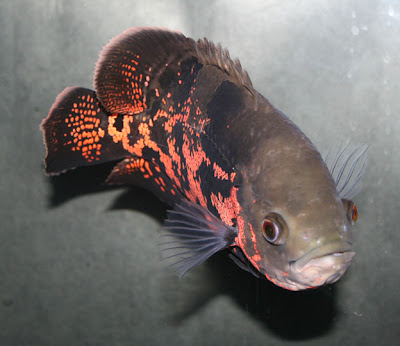Oscar Fish

A very intelligent fish that can recognize its owner, the heavily built Oscar is an all-time favorite among aquarium hobbyists. Originally imported from South America, most Oscars for sale are now tank-bred. A large aquarium of at least 70 gallons is required to house a pair of Oscars. The Oscar fish has his own ideas on how to decorate what he considers his home (your aquarium!) he will grab any object including small rocks and plants (doesn't care whether they are natural or artificial) and spit them out of the tank if he doesn't like them -a deep sand bottom and few large rocks will save you a lot of headaches.Oscars have hearty appetites and should only be kept with fish that are the same size or larger; smaller fish soon become a quick snack for the Oscar. Other South American cichlids and large catfish make good tankmates.
Occasionally the Oscar will pretend he's dying and will lay down on the bottom of the aquarium (don't worry oscars are excellent actors) he will wait for small fishes to get closer, those naďve enough to buy his tricks will not live long to tell their story; although some people recommend feeding them live goldfish and guppies I personally do not like the idea as you take a real chance of introducing diseases, instead you can feed them vegetarian cichlid pellet, peas, lettuce (this is important to prevent hith disease) blended beef heart, earthworms and shrimps.
Feeding
Most fish eaten by A. ocellatus in the wild are relatively sedentary catfish, and included Bunocephalus, Rineloricaria and Ochmacanthus species. The species uses a suction mechanism, generated by portable pump, to capture prey, and has been reported to exhibit "laying-on-side" death mimicry in a similar fashion to Parachromis friedrichsthalii and Nimbochromis livingstonii. The species also has an absolute requirement for vitamin C and develops health problems in its absence.

Selective breeding
A number of ornamental varieties of A. ocellatus have been developed for the aquarium industry. These include forms with greater intensity and quantities of red marbling across the body, albino, leucistic and xanthistic forms. A. ocellatus with marbled patches of red pigmentation are sold as red tiger oscars, while those strains with mainly red colouration of the flanks are frequently sold under the trade name of red oscars. The patterning of red pigment differs between inidividuals, in the United Kingdom one A. ocellatus reportedly had markings that resembled the Arabic word for "Allah". In recent years long-finned varieties have also been developed. The species is also occasionally artificially coloured by a process known as painting.
In the aquarium
A. ocellatus are popular as pets, are regarded as intelligent by aquarists, and are one of the hardiest freshwater fish in the aquarium trade. The reason for this, in part,is because they can learn to associate their owners with food and are purported to be able to distinguish their owner from strangers.
Despite their large size and predatory nature A. ocellatus are relatively placid aquarium residents best housed with other fishes too large to be considered food items.
A. ocellatus are known to uproot plants, and move other objects in aquariums and are best maintained in volumes of 200-600 litre (75 or more gallons). A. ocellatus is relatively tolerant of a range of typical aquarium water chemistries, though its large size and messy feeding habits necessitates that efficient filtration be installed on the aquarium. A. ocellatus is undemanding to feed in captivity and will accept a range of foods that include pieces of fish, prepared cichlid foods, and even small household lizards. Oscars may also tend to jump out of an aquarium if the lid isn't supported sufficiently.
Oscars are known to beg for food when their owners approach the tank. Some owners report being able to feed their fish by hand and even pet their Oscar fish. Be aware, however, that doing so can harm their protective slime barrier.
Distribution and habitat
A. ocellatus is native to Peru, Colombia, Brazil and French Guiana and occurs in the Amazon river basin, along the Amazonas, Içá, Negro, Solimões and Ucayali river systems, and also in the Approuague and Oyapock drainages. In its natural environment the species typically occurs in slow moving white-water habitats, and has been observed sheltering under submerged branches. Feral populations also occur in China, northern Australia, and Florida, USA as a by-product of the ornamental fish trade. The species is limited in its distribution by its intolerance of cooler water temperatures, the lower lethal limit for the species is 12.9 °C (55.2 °F).
![[Red+Tiger+Oscar.jpg]](https://blogger.googleusercontent.com/img/b/R29vZ2xl/AVvXsEjiLEA6GP6frsAiFgiKi1zdM4rl5RgVXClxwSoGwx23x6hIBHBQgQ15VnG96Ek-fMWXvn1mcM02rUXrYAOYYST5VmN24IuP4lCqZ52gAC-oKlzqFM0KCdTz8ibzX13Kudk93TtPteRPtMF6/s1600/Red+Tiger+Oscar.jpg)